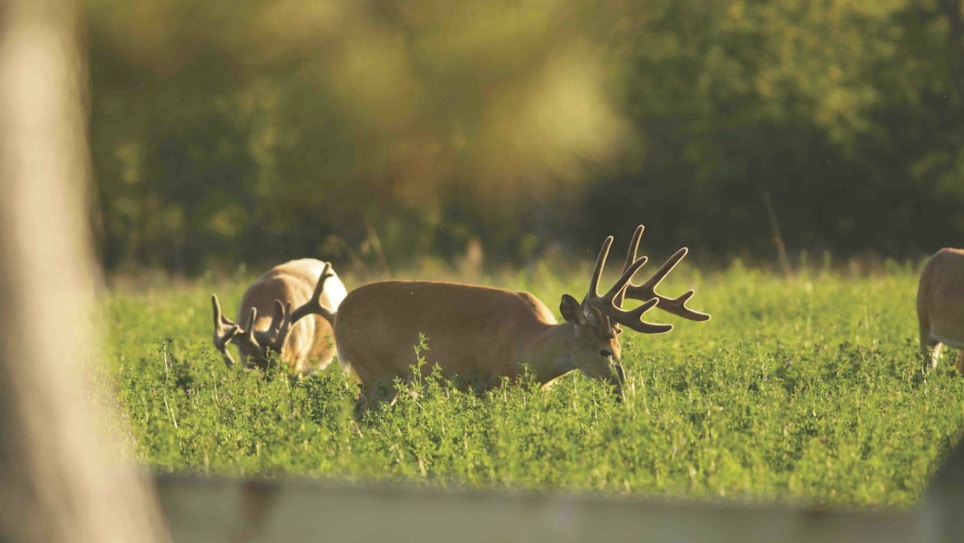When you think about August gatherings, it would be hard to compete with the 1969 summer of Woodstock. Whitetail hunters might have a different answer though. For most, a bachelor gathering of bucks on a summer field trumps a field full of hippies. Late-summer buck sightings signal hunting season is dead ahead. It also signals it’s time for you to set stands if you haven’t already.
Full Potential
A few of you may have an intimate relationship with your hunting property. You knew years ago where to place stands based on the land’s layout. Nevertheless, many of us live in a changing hunting environment due to weather and especially the whims of the local farming community. Alternating crops and a never-ending modification of farming practices requires you to stay on focus to buck adjustments to these possible deviations. August provides the answers on several levels leading to an opening-day or beyond ambush plan.
Begin with visibility. Lavishing months without hunting pressure and surrounded by the best feed of the year prompts bucks into a lackadaisical, browsing nature. They traipse around in a band of brothers and that band represents safety. More eyes, ears and noses equal more security and lower odds of predators sneaking into pouncing range. Because of that breathe-easy lifestyle they feed in daylight giving you time to survey patterns. Visual sightings combined with trail cameras along trails helps confirm the best ambush locations for you.
You can also zero in further for a trap by picking out the best of the best. The intelligence you gather while watching summertime bucks gives you the goods on any trophy standouts. By August bucks are done cooking in the antler department. August is the month where antlers mineralize and finish the hardening process before the velvet is stripped in September. Visual an August buck without its velvet and you’ll see the proportions of the animal you’ll hunt later.
Most bachelor bucks enter and leave fields as a gang, but some mature animals may join the group from a different corner or habitat zone on a property. Once you fancy a particular buck pay special attention to that standout for stand adjustments based on their movement idiosyncrasies.
Set and Forget
Procrastination is an everyday flaw of humankind. I’m doing it right now penning this column late and you likely put off taking out the garbage. Despite this inherent lapse in our DNA, being a procrastinator with deer stand positioning could cost you more than a smelly kitchen. It could cost you your buck.
Regardless if you plan on hunting a property on September 1 or November 1, having stands in place by summer’s end boosts success on a season-long game plan. By late summer you have the agricultural layout of a property. If agriculture is a small allotment of the parcel then you will need to scout whitetail browse options and mast, like acorns. They’ll serve as the field replacement, but still have drawing potential during season.
With this intelligence in hand and a look into the crystal ball, take the time to put stands in place. August provides an ideal window for several reasons. Witnessing real-time bucks in daily action tops the list, but setting your stands or blinds several weeks before an early-season opener allows your intrusion to be forgotten. In much of whitetail country, August still hosts a medley of field activity that provides opportunity to meld stand intrusions with haying, spraying, livestock rotations and other farmland field chores.
Even if you can’t time your ambush setup with a farming activity, deer won’t necessarily be able to tell the difference unless you barge right into a bedroom. A good plan is to focus on edge locations when deer are tucked tight in bedding cover. Follow your hunting routine and utilize a scent-free approach, particularly with footwear and hand scent you may leave around a tree trunk. Scent-eliminating sprays, properly-laundered clothes and even latex gloves can aid in invisibility.
To further make your infringement less threatening look at the forecast. Pick a day that has a breezy forecast or a chance of showers. These conditions help you cloak your presence when you want to intrude beyond field edges to cover adjacent to bedrooms. Try to avoid a day with the threat of thunderstorms though.

One blustery, summer afternoon I decided to hang several stands in river-bottom cover. Just as I finished a typical, late-afternoon thunderstorm boiled up in the west. Seeing that this storm was building potential I hurried my work, but the storm had a different plan. While hiking out the storm exploded with a barrage of marble-sized hail. To avoid a painful pelting I found a hollow log and was able to cram myself into part of the decayed recess. It worked although I watch the hourly forecast on my ScoutLook Weather hunting app with a bit more scrutiny these days.
Say you don’t plan to hunt the September opener. An August hunt improvement plan still holds merit. As fall plays out would you rather be out hanging stands or hunting from a stand? Your schedule likely doesn’t give you any more extra time in August as it does in November. Nevertheless, skipping a visit to the beach in August to prep a hunting property delivers more hunting time in November. And as suggested earlier, early stand setup disturbances quickly disappear in the minds of whitetails. You will make some noise and commotion with setup chores varying from widening your access trails to clearing shooting lanes when foliage is at its fullest. Finalize all of this work well before the opener and any disturbance will be a distant memory for local whitetails.
The stands I hung in the hailstorm were set for an early-season opener with focus on hayfield traffic. However, an unexpected layover in elk country dashed my early-season opportunity back in whitetail country. Despite the lost time I discovered a few weeks later the stands were still holding promise. On my first October sit the whitetails were still devoted to the earlier pattern. One frosty morning I watched a trio of bucks slip off the hayfield at daybreak. They filed my way in single file based on a pecking order set back in September. After crossing a river they stopped to reassess an entrance to the bedroom. Whew, they picked my route! Three minutes later I drew my Mathews for a downward, angling 15-yard shot on the biggest to end a hunt that started way back in an August storm.
Sidebar: Range When Prepping
When you set summer stands don’t forget to bring your rangefinder along. It has several purposes. First, as you clear shooting lanes you can range all shot opportunities to get an idea if your clearing project is a good investment or a waste of time due to extreme distances, or obstacles. Second, you can pre-range the obvious or dream shots you hope to happen. Utilizing surveyor’s tape or even surveyor’s flags, mark all distances utilizing easy-to-remember distances such as 20, 30 and 40 yards.
The Sig Sauer Electro-Optics offers an economical line of rangefinders to get the job done. Their Kilo series including the 850 model, starts at less than $180 for a rangefinder with incline/decline calculations and an accuracy of .1 yards under 100 yards. It also has the ability to range to distances up to 1,200 yards so even long-range rifle shooters can utilize it outside of archery season. If you get off on technology look at the Sig Sauer BDX series that pairs instant range readings with your riflescope and adjusts the reticle illuminated dot automatically.







